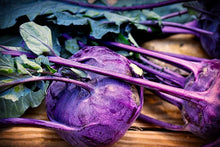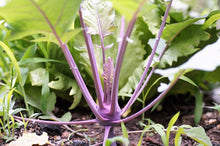The Italians first cultivated kohlrabi in the 1500s. Sometime during the 1600s-1700s the vegetable made it to the US. Purple Vienna is the earliest and sweetest of the varieties. The unearthly looking plants are 10-12 in. tall with reddish purple, bulbous roots that grow on top of the soil. Roots are best-harvested young (2 in. diameter).
Because of its turnip-like appearance, kohlrabi is sometimes misclassified as a root vegetable. Leaves stand out like little spokes on the sides and top of the edible, enlarged stem. You'll welcome not only kohlrabi's unusual shape, but also its crisp texture and wonderful, delicately sweet, nutty, and very slightly peppery.
Kohlrabi (Brassica Oleracea Gongylodes Group), also called German turnip, is a biennial vegetable, a low, stout cultivar of wild cabbage. It is another cultivar of the same species as cabbage, broccoli, cauliflower, kale, Brussels sprouts and collard greens. It can be eaten raw or cooked. Edible preparations are made with both the stem and the leaves. Despite its common names, it is not the same species as turnip.
Click here to download our free vegetable growing guide





